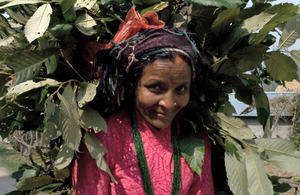DFID Research: Managing forest rights in Nepal
A DFID-funded Research into Use initiative is helping local communities in Nepal live with potential vulnerability induced by climate change

The Sundari communities in Nepal rely on forest products. Picture: RIU
Climate change is creating real changes in the Nepal Himalaya, and the effect is more pronounced in the mountains than in the low-lying areas. Georgina Smith visited the Sundari community to see how a DFID-funded Research into Use (RIU) initiative is helping local communities cope with the risks associated withclimate change.
As smoke rises amidst the thick russet forests stretching up into the hills of Nawalparasi in Nepal, there is no one at home in the Sundari community. They are all out - fire fighting in the forest. Regardless of the time of day, when fires strikes, the forest people defend the trees and their fruits with their lives. Without the forest, these communities would have no food, no fuel, no income and no home.
The fiercest firefighters arrive on the scene first and they leave last. They are also often the poorest forest people, marginalised from the most fertile land and prevented from earning a living for themselves. Subarna Ale Magar is a member of the marginalised Dalit community. She lives with her family near the thick forest cover of the Sundari group.
Like many people working in the forests, Badri Prasad, chairman of the Sundari group, knows how people like Subarna rely on and protect the forest. “We realised that poor people contribute a lot to the forest,” he said. “The main moto of the community is to support the poorer people. We have provided land for some groups so they can harvest the forest.”
In Nepal’s forests, conflict is inevitable. The land is owned by the government, but communities must manage the timber and other forest products amongst themselves. There is often encroachment by powerful groups onto fertile land - and poorer groups such as the Dalits are literally pushed off their land.
Forest Action helps forest communities with advice and support
The Sundari community is one group benefiting from the advice of the organisation Forest Action, which targets about 20,000 people in the forests of Kathmandu, Nawalparasi and Baglung, with management advice.
Thinking, planning, scientific research and a strong coalition of partners supporting and offering advice to communities on every front - from policy to business acumen - are the weapons used in the fight against negative hierarchy, marginalisation, poverty and now climate change.
Supported by the Research into Use, Challenge Fund Programme, Forest Action’s partners include the Federation of Community Forest Users of Nepal, which strives to combat hierarchical policy and encourages social equity; the department of Sociology and Anthropology at the University of Tribhuvan in Kathmandu; Nepal Herbs and Herbal Products Association and the Nepal Forum of Environmental Journalists, to spread the word. They join together to create a strong and unique force to champion the rights of forest people.
Meetings are called regularly between forest group members to decide which trees should be protected, which ones cut down to make way for others, and which ones pruned to increase the value of the timber. Communities are taught how the forest can be managed to get the most out of it - how to carry out forest assessments and inventories so that they are aware of what stock they have and how much they can legally harvest to get an income.
Chinese plum, bamboo and forest fruits like Alma - all these are rich forest produce to be reaped. The trees can be cut down if numbers are controlled; firewood can be chopped and berries and livestock fodder can be harvested if conservation is agreed. The forests can also be managed better to preserve biodiversity and attract tourists.
Anita Rana Magar, Chairman of the Shreeganesh forest group based in Kathmandu valley, is one of the few female chairwomen in the area, and has fought hard to make the most of the forest. “We have made a ten-year plan based on our vision,” she said.
“We have a plan for barbed wire fencing, plantation of Chinese plum and bamboo - and we have a very optimistic plan for enterprises based on these. We are excited about the future,” she added. It all comes down to one thing - knowledge. For these forest communities, knowledge really is power.
More information
The RIU initiative led by Forest Action seeks to strengthen the poor and women to engage in collective actions, networks and governance of community forestry processes. It aims to scale out the tools, which provide opportunities to the poor to voice their concerns in the governance of forest resources and will help devise pro-poor forest management strategies, and thus reduce the overall vulnerability of the poor.
See also details of the earlier DFID-funded research projects: Dissemination of research findings regarding community forestry in Nepal
Social structure, livelihoods and the management of CPRs in Nepal